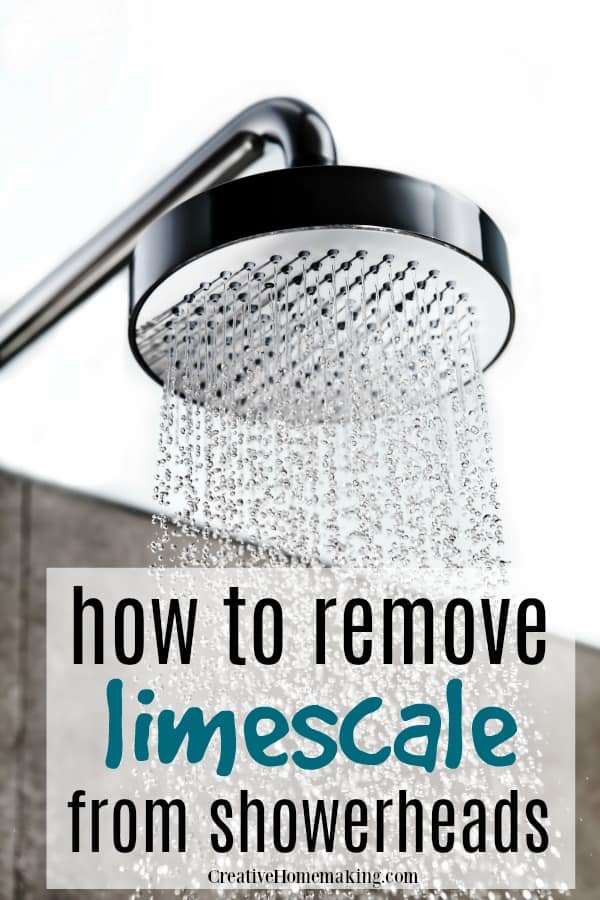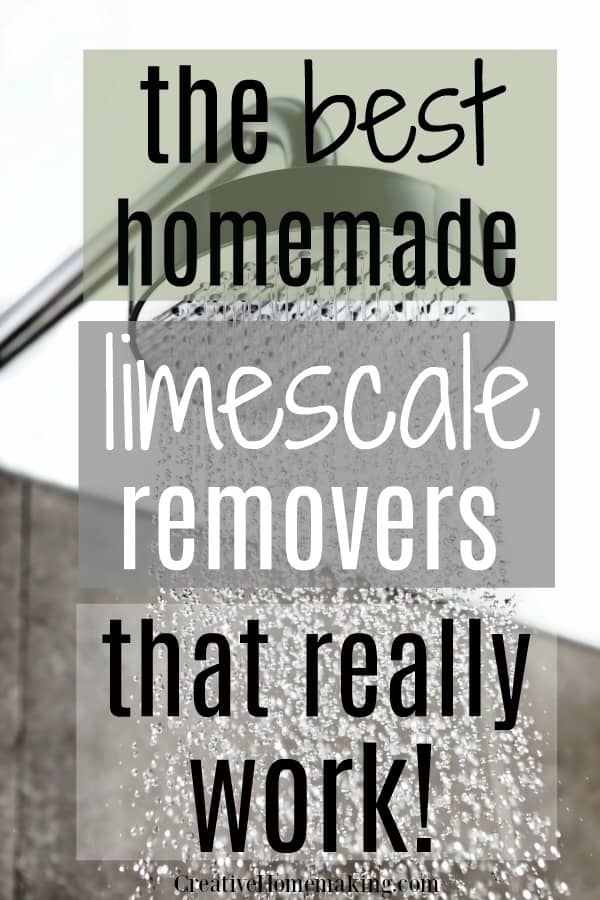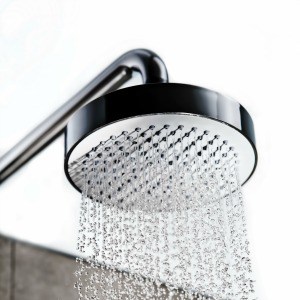Are you tired of dealing with stubborn limescale stains in your bathroom or kitchen? Limescale build-up is a common problem caused by hard water, which can leave unsightly white or grayish stains on your taps, showerheads, and sinks.
This post may contain affiliate links.
Fortunately, there are natural limescale remover methods that can help you tackle this issue without resorting to harsh chemicals or expensive cleaning products.
Understanding Limescale
If you’ve ever noticed a chalky white buildup on your kitchen or bathroom fixtures, you’ve likely encountered limescale.
Limescale is a hard, chalky deposit that forms when water with high mineral content, particularly calcium and magnesium, evaporates or is heated. Hard water contains dissolved minerals that crystallize and adhere to surfaces, leading to the formation of limescale.
Related Article: How to Easily Remove Hard Water Stains from Your Toilet
Calcium carbonate is the primary component of limescale, making it difficult to remove from your kitchen and bathroom fixtures.
It can build up in your showerhead, faucets, bathtub, and toilet bowl, making them look dirty and unsightly.
Limescale can also cause problems with your appliances, such as your coffee maker, dishwasher, and washing machine.
The buildup can cause these appliances to work less efficiently, leading to higher energy bills and the need for more frequent repairs.

If you live in an area with hard water, you’re more likely to encounter limescale buildup. You can test the hardness of your water by using a water hardness test kit, which you can find at most hardware stores.
Understanding limescale is the first step in removing it from your home. By using a natural limescale remover, you can effectively remove buildup without the use of harsh chemicals.
Vinegar, for example, is a natural limescale remover that contains acetic acid, which can dissolve most mineral deposits, including limescale, grease, and grime build-up. Other natural limescale removers include lemon juice, baking soda, and citric acid.
Natural Limescale Removers
If you’re looking for a natural way to remove limescale from your kitchen or bathroom fixtures, there are several methods you can try. Here are three of the most effective:
Lemon Juice Method
Lemon juice is a natural acid that can help to dissolve limescale. To use this method, cut a lemon in half and rub it over the affected area.
Alternatively, you can squeeze the juice of a lemon into a spray bottle and spray it onto the limescale. Let the lemon juice sit for a few minutes, then wipe it away with a damp cloth. Repeat as necessary until the limescale is gone.
Vinegar Solution Method
A solution of half white vinegar and half water can also be an effective limescale remover. Soak a kitchen towel in the vinegar solution and wrap it around your kitchen or bathroom faucet fixture.
Let it sit overnight and rinse the next day. Scrub with an old toothbrush if necessary. You can also use lemon juice in place of the vinegar for an extra boost.

Baking Soda Method
Baking soda is a natural abrasive that can help to scrub away limescale. Mix baking soda with a small amount of water to form a paste. Apply the paste to the affected area and let it sit for a few minutes.
Scrub the area with a sponge or brush, then rinse with water. Repeat as necessary until the limescale is gone.
These natural limescale removers can be just as effective as store-bought products, without the harsh chemicals. Plus, they’re often less expensive and better for the environment. Try one of these methods today and see the difference for yourself.
How to Remove Limescale
Limescale buildup can be a frustrating and unsightly problem. Fortunately, there are several natural solutions that can help you remove limescale from your kitchen appliances, bathroom fixtures, and household items. Here are some effective methods that you can try.
From Kitchen Appliances
If you have limescale buildup in your kettle, coffee machine, or dishwasher, white vinegar can be an effective solution.
Simply fill the appliance with a solution of half water and half white vinegar, and let it sit overnight. In the morning, rinse the appliance thoroughly to remove any remaining limescale.
From Bathroom Fixtures
Limescale buildup can also be a problem on bathroom fixtures such as sinks, toilets, and showerheads. For sinks and toilets, you can use a mixture of half white vinegar and half water to remove limescale buildup.
Simply soak a cloth in the vinegar solution and wrap it around the affected area, letting it sit for several hours or overnight. For showerheads, you can remove the buildup by soaking the head in a bag of white vinegar for a few hours, then rinsing it thoroughly.
From Household Items
Limescale can also build up on household items such as tiles, irons, and washing machines. To remove limescale from tiles, you can use a mixture of white vinegar and water and scrub the tiles with a brush.
For irons, you can fill the iron with a solution of half white vinegar and half water and let it steam for a few minutes. For washing machines, you can run a cycle with a cup of white vinegar to remove any limescale buildup.
Remember to always rinse thoroughly after using any of these methods to remove limescale. With a little effort and the right natural solutions, you can keep your home free of limescale buildup.
Preventing Limescale Buildup
Limescale buildup can be a frustrating problem in your home, but there are ways to prevent it from happening in the first place. Here are a couple of methods that can help you prevent limescale buildup:
Water Softeners
One of the most effective ways to prevent limescale buildup is to install a water softener. Hard water is the main culprit behind limescale buildup, and water softeners work by removing the minerals that cause hard water.
Water softeners come in different types, such as salt-based and salt-free, and can be installed at the point of entry or point of use.
Installing a water softener can help you save money in the long run by reducing the need for limescale removers and extending the lifespan of your appliances.
Filters
Another way to prevent limescale buildup is to install filters in your fixtures. Filters work by removing the minerals that cause hard water, just like water softeners.
However, filters are less effective than water softeners and need to be replaced more frequently. Filters can be installed in your showerhead, faucet, or any other fixture that comes into contact with water.
Installing filters can help you reduce the amount of limescale buildup in your fixtures and make cleaning easier.
Health and Environmental Considerations
When it comes to removing limescale, you want to make sure that the products you use are not only effective but also safe for your health and the environment. Here are some things to consider:
Health
Many commercial limescale removers contain harsh chemicals that can be harmful to your health. These chemicals can cause skin irritation, respiratory problems, and even chemical burns if not handled properly.
By using natural limescale removers, you can avoid these health risks and still get your surfaces looking clean and shiny.
Eco-Friendly
Traditional limescale removers are not only bad for your health but also for the environment.
The harsh chemicals used in these products can be harmful to aquatic life and can pollute our waterways. By using natural limescale removers, you can help reduce your impact on the environment.
Related Article: Removing Hard Water Stains in Sinks
Ingredients
The ingredients used in natural limescale removers are often simple and safe. For example, vinegar and lemon juice are common ingredients used to remove limescale. These ingredients are not only safe for your health and the environment but are also readily available and affordable.
Effectiveness
Natural limescale removers may not be as powerful as their chemical counterparts, but they can still be effective. With a little elbow grease and some patience, you can remove even the toughest limescale stains using natural products.
Cost
Natural limescale removers are often more affordable than their chemical counterparts. You can easily make your own limescale remover using ingredients you already have at home, which can save you money in the long run.
Commercial Limescale Removers
When it comes to removing limescale, sometimes natural methods might not be enough. In that case, commercial limescale removers can be a good option. However, it is important to use them safely and responsibly, as they contain chemicals that can be harmful if not used properly.
Related Article: How to Remove Rust Stains from Porcelain Sinks or Bathtubs
CLR
CLR is a popular brand of limescale remover that is available on Amazon. It is a powerful formula that can remove tough limescale and rust stains from various surfaces.
However, it is important to read the instructions carefully before use, as it contains chemicals that can be harmful if not used properly.
To use CLR, you should apply it directly to the affected area and let it sit for a few minutes. Then, you can scrub the area with a brush or sponge and rinse it with water. It is important to wear gloves and protective eyewear when using CLR, and to keep it away from children and pets.
Descaling Liquid
Another option for commercial limescale remover is descaling liquid. This type of product is designed specifically for removing limescale from household appliances such as coffee makers, kettles, and washing machines.
Descaling liquid is usually applied by diluting it with water and running it through the appliance according to the manufacturer’s instructions. It is important to follow the instructions carefully, as using too much or too little of the product can be ineffective or even harmful.
When using descaling liquid, it is important to wear gloves and protective eyewear, and to keep the product away from children and pets. Additionally, it is important to rinse the appliance thoroughly with water after using descaling liquid to ensure that no residue is left behind.
Overall, commercial limescale removers can be a good option for tough limescale stains. However, it is important to use them safely and responsibly, and to follow the instructions carefully.
Practical Tips for Limescale Removal
Limescale buildup is a common problem in households with hard water. Luckily, there are many natural and inexpensive ways to remove limescale effectively. Here are some practical tips for limescale removal:
Use Natural Cleaners
Natural cleaners such as vinegar, lemon juice, and baking soda can be great alternatives to harsh chemical cleaners. They are cheap, efficient, and safe to use.
You can make a cleaning solution by mixing vinegar and water in a spray bottle and use it to clean bathroom tiles, glass shower doors, and taps. For tough limescale stains, you can use a mixture of baking soda and vinegar.
Invest in a Pumice Stone
A pumice stone is a natural abrasive that can be used to remove limescale from toilets, sinks, and taps.
Wet the stone and gently rub it on the affected area until the limescale is scrubbed away. Be careful not to use too much force as it can scratch the surface.
Related Article: How to Clean Rusty Colored Shower Curtains
Use Hydrogen Peroxide
Hydrogen peroxide is another natural cleaner that can be used to remove limescale. Mix equal parts of hydrogen peroxide and water in a spray bottle and use it to clean household appliances such as coffee makers and steam irons. It can also be used to remove limescale from shower heads.
Use a Tea Towel
For tough limescale stains, you can use a tea towel soaked in vinegar. Wrap the tea towel around the tap or spout and leave it for a few hours. The acidity of the vinegar will help dissolve the limescale.
Use Rubber Gloves
When removing limescale, it is important to protect your hands with rubber gloves. Limescale can be tough on the skin and can cause irritation.
In conclusion, removing limescale can be a simple and easy task with the right tools and techniques.
By using natural cleaners, investing in a pumice stone, and using hydrogen peroxide, you can effectively remove limescale buildup from your household appliances and bathroom fixtures. Remember to wear rubber gloves when handling limescale and always follow safety precautions.
Related Article: Removing Water Marks from Windows
Frequently Asked Questions
What are some effective natural remedies for removing limescale?
There are several natural remedies that can be effective in removing limescale, including lemon juice, white vinegar, baking soda, and citric acid. These ingredients have natural acidic properties that can help break down the buildup of limescale on surfaces.
What ingredients should I look for in a natural limescale remover?
When looking for a natural limescale remover, you should look for ingredients that have natural acidic properties, such as lemon juice, white vinegar, and citric acid. You may also want to look for ingredients that are environmentally friendly and safe for use around children and pets.
Can natural limescale removers be used on all surfaces?
While a natural limescale remover can be effective on many surfaces, they may not be suitable for use on all surfaces. For example, some natural remedies may be too acidic for use on delicate surfaces such as marble or granite.
It’s always a good idea to test a small, inconspicuous area before using any natural limescale remover on a larger surface.
Are there any natural limescale removers that are safe for septic systems?
Yes, there are natural limescale removers that are safe for septic systems. Ingredients such as baking soda and borax are safe for use in septic systems and can be effective in removing limescale buildup.
Which is better for removing limescale, vinegar or lemon juice?
Both vinegar and lemon juice can be effective in removing limescale buildup. Vinegar is more acidic than lemon juice, which may make it more effective on tough buildup.
However, lemon juice has a pleasant scent and can be a good alternative for those who don’t like the smell of vinegar.
What is the best way to prevent limescale buildup in my appliances?
One of the best ways to prevent limescale buildup in appliances is to regularly clean them with a natural limescale remover.
You can also use a water softener or install a water filtration system to reduce the amount of hard water in your home. Additionally, wiping down surfaces after use and using a squeegee to remove excess water can help prevent limescale buildup.
Follow my cleaning hacks board on Pinterest.




Vinegar is so versatile and a great green cleaning solution. I dont have headaches anymore after cleaning with it. Great Tip!
Baking soda and vinegar clean everything except soul 😀
Really useful article
Thanks!